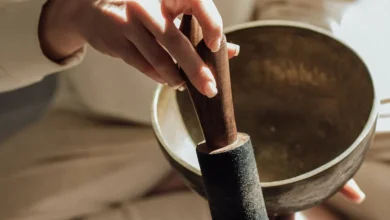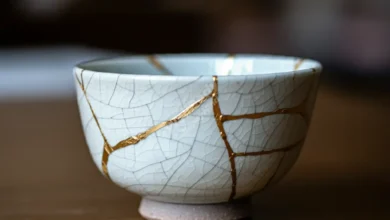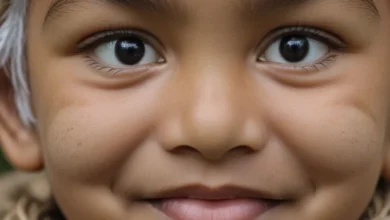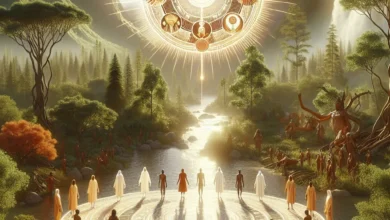Dance of the Maori: Healing Through Haka

Imagine a group of people, their faces contorted with intense expressions, bodies moving in perfect unison, voices rising in a powerful chant. This is the Haka, a traditional Maori dance that’s much more than just a performance. Did you know that this ancient practice, often associated with New Zealand’s rugby team, is actually a powerful tool for healing and well-being?
The Haka, deeply rooted in Maori culture, has evolved from a war dance into a multifaceted cultural expression. In this article, we’ll explore how this dynamic dance can be a source of:
- Emotional release
- Stress relief
- Physical health benefits
Get ready to discover the healing power of the Haka and how it might just change your perspective on cultural practices!
The Origins of Haka

The Haka is an ancient and integral part of Maori culture, with roots stretching back centuries in New Zealand’s rich history. Originally, this powerful performance was a war dance, designed to intimidate enemies and showcase the strength and unity of Maori warriors.
Over time, the Haka has evolved into much more than just a pre-battle ritual. It has become a versatile form of cultural expression, used to:
- Welcome honored guests
- Celebrate important achievements
- Mark significant life events
- Express grief at funerals
There isn’t just one type of Haka. In fact, there are several variations, each with its own purpose and significance:
- Ka Mate: The most famous Haka, often performed by New Zealand’s All Blacks rugby team
- Tika Tonu: A Haka that speaks about self-belief and confidence
- Ko Uhia Mai: A ceremonial Haka used for formal occasions
- Powhiri: A welcoming Haka performed for visitors
This transformation from a war dance to a multifaceted cultural practice demonstrates the adaptability and resilience of Maori traditions. The Haka continues to play a crucial role in preserving and celebrating Maori heritage while also gaining recognition and respect worldwide.
Understanding the Elements of Haka

The Haka is a complex and powerful performance that combines various physical and vocal elements. Each component plays a crucial role in creating the intense, emotional experience that is characteristic of this Maori cultural practice.
Physical Components
The physical aspects of Haka are dynamic and expressive:
- Foot-stamping: Rhythmic and forceful, symbolizing connection to the earth
- Body slapping: Usually on the thighs or chest, creating percussive sounds
- Facial expressions: Intense, often including wide eyes and protruding tongues
- Hand gestures: Varied and meaningful, often telling a story or conveying emotions
Vocal Components
The vocal elements are equally important:
- Chanting: Rhythmic recitation of words, often in the Maori language
- Shouting: Powerful vocalizations that add intensity to the performance
Spiritual Significance
Beyond the physical and vocal elements, the Haka holds deep spiritual meaning for the Maori people. It’s seen as a way to:
- Connect with ancestors
- Express cultural identity
- Channel and release emotional energy
- Unite the community in a shared experience
Each movement, gesture, and sound in the Haka is imbued with cultural significance, making it a rich and meaningful practice that goes far beyond its outward appearance.
Haka as a Healing Practice

The Haka, while visually striking and culturally significant, also serves as a powerful healing practice. Its unique combination of physical movement, vocalization, and community engagement offers numerous benefits for mental, emotional, and physical well-being.
Emotional Release
One of the most profound healing aspects of Haka is its ability to facilitate emotional release. Through its intense movements and vocalizations, participants can:
- Express pent-up emotions
- Process grief or anger in a healthy way
- Feel a sense of catharsis and relief
Building Community and Social Bonds
Haka is typically performed as a group, which helps in:
- Strengthening social connections
- Fostering a sense of belonging
- Promoting unity and collective identity
These social aspects are crucial for mental health and overall well-being.
Stress Relief and Mental Health Benefits
Engaging in Haka can have significant positive impacts on mental health:
- Reduces stress through physical exertion and rhythmic breathing
- Boosts self-confidence and self-esteem
- Provides a sense of accomplishment and cultural pride
Physical Health Benefits
The physical nature of Haka also contributes to improved health:
- Cardiovascular exercise: Increases heart rate and improves circulation
- Muscular engagement: Strengthens various muscle groups
- Improved coordination: Enhances body awareness and control
- Better posture: Encourages an upright, confident stance
By combining physical activity with emotional expression and community engagement, Haka offers a holistic approach to healing that addresses multiple aspects of well-being simultaneously.
The Science Behind Haka’s Healing Power
While the healing effects of Haka have been known to Maori culture for generations, modern science is now catching up to explain why this practice can be so beneficial for our well-being.
Physical Movement and Mental Health
Research has shown that vigorous physical activity, like that found in Haka, can have significant positive effects on mental health:
- Releases endorphins, the body’s natural “feel-good” chemicals
- Reduces levels of stress hormones like cortisol
- Improves mood and decreases symptoms of anxiety and depression
The intense, full-body movements of Haka provide an excellent form of exercise that can contribute to these mental health benefits.
Rhythmic Breathing and Stress Reduction
The controlled breathing that’s part of Haka performance has been linked to stress reduction:
- Activates the parasympathetic nervous system, promoting relaxation
- Lowers heart rate and blood pressure
- Improves focus and mindfulness
This aspect of Haka shares similarities with meditation and deep breathing exercises, both well-known for their stress-relieving properties.
Community Engagement and Well-being
The social aspect of Haka aligns with research on the importance of community for mental health:
- Increases feelings of social support and belonging
- Reduces feelings of isolation and loneliness
- Promotes a sense of shared identity and purpose
Studies have consistently shown that strong social connections are crucial for mental and physical health, and Haka provides a powerful way to foster these connections.
By combining physical activity, controlled breathing, and community engagement, Haka creates a perfect storm of factors that contribute to overall well-being, as supported by scientific research.
Modern Applications of Haka
While Haka remains deeply rooted in Maori culture, its powerful effects have led to its adoption in various modern contexts. Here’s how this traditional practice is being applied in contemporary settings:
Use in Sports Teams
Haka has become famous worldwide through its use in sports, particularly:
- New Zealand All Blacks: The national rugby team performs Ka Mate before matches
- New Zealand Warriors: The professional rugby league team uses Haka
- New Zealand national basketball team: Performs Haka before international games
These performances not only intimidate opponents but also:
- Build team unity
- Boost morale and confidence
- Connect players to their cultural heritage
Incorporation in Therapy and Counseling
Mental health professionals are beginning to recognize the therapeutic potential of Haka:
- Used in group therapy sessions to encourage emotional expression
- Applied in anger management programs
- Incorporated into trauma recovery therapies
The physical and emotional release provided by Haka can be a powerful tool in these therapeutic contexts.
Haka in Schools and Educational Settings
Many schools, particularly in New Zealand, are incorporating Haka into their curriculum:
- Teaches students about Maori culture and traditions
- Promotes cultural understanding and respect
- Builds confidence and self-expression skills in students
- Encourages physical activity and teamwork
By bringing Haka into the classroom, schools are helping to preserve this cultural practice while also benefiting students’ personal development.
These modern applications demonstrate how the healing power of Haka can be harnessed in various contexts, extending its benefits beyond traditional cultural settings and into everyday life.
Learning Haka: A Step-by-Step Guide
While mastering Haka takes time and practice, here’s a simple guide to help you understand its basic elements. Remember, Haka is a sacred cultural practice, so approach it with respect and seek proper instruction for a full experience.
Basic Stance and Posture
- Stand with feet apart: About shoulder-width distance
- Bend your knees slightly: This gives you a strong, grounded stance
- Keep your back straight: Maintain an upright posture
- Chest out, shoulders back: This shows confidence and strength
Simple Hand Movements
- Pākia (slap): Open palm slap on the thighs or chest
- Whakarewa (raise): Lift your hands up, palms facing outward
- Whakahuhu (tremble): Shake your hands with fingers spread
Facial Expressions
- Widen your eyes: This is called ‘pūkana’ and is a key part of Haka
- Stick out your tongue: Known as ‘whētero’, this is another important expression
- Show intensity: Your face should convey strong emotion
Beginner’s Chant
Here’s a simple, two-line chant to practice with:
“Ka mate, ka mate! Ka ora, ka ora!”
(I may die, I may die! I may live, I may live!)
Pronunciation guide:
- Ka: like “car” without the ‘r’
- Mate: “mah-teh”
- Ora: “oh-rah”
Remember, learning Haka is about more than just movements. It’s about connecting with the culture and spirit behind the practice.
The Cultural Significance of Haka Today
While Haka has gained global recognition, its deep cultural roots and significance within Maori society remain paramount. Understanding this context is crucial to appreciating Haka beyond its surface-level appeal.
Haka in Maori Ceremonies
Haka continues to play a vital role in various Maori ceremonies:
- Weddings: Celebrating unions and honoring families
- Funerals (Tangihanga): Expressing grief and paying respects
- Welcoming ceremonies (Powhiri): Greeting important visitors
- Birthdays and anniversaries: Marking significant life milestones
These performances strengthen community bonds and maintain cultural traditions.
Role in Preserving Maori Heritage
Haka serves as a living link to Maori ancestry and history:
- Oral tradition: Haka often tells stories of ancestors and historical events
- Language preservation: Many Haka are performed in te reo Maori, helping keep the language alive
- Cultural values: Haka embodies and transmits important Maori values like strength, unity, and respect
By practicing and sharing Haka, younger generations connect with their heritage and keep traditions alive.
Global Recognition and Respect
While rooted in Maori culture, Haka has gained worldwide appreciation:
- Cultural exchange: Haka performances at international events promote understanding
- Increased awareness: Global interest in Haka has led to more people learning about Maori culture
- Respect for indigenous practices: Haka’s prominence has contributed to broader recognition of indigenous cultural expressions
However, it’s crucial to approach Haka with respect, understanding its sacred nature within Maori culture.
The enduring significance of Haka in modern Maori life, coupled with its growing global recognition, demonstrates its power as both a cultural treasure and a bridge between communities.
Experiencing Haka: Where to Watch and Participate

For those interested in experiencing the power of Haka firsthand, there are several ways to watch performances or even participate in this meaningful cultural practice.
Cultural Centers and Museums
Many cultural institutions offer opportunities to learn about and experience Haka:
- Te Papa Museum (Wellington, New Zealand): Regular Haka performances and educational programs
- Auckland War Memorial Museum: Offers daily cultural performances including Haka
- Rotorua Maori Arts and Crafts Institute: Features traditional Maori performances, including Haka
These venues provide a respectful and educational context for experiencing Haka.
Maori Villages in New Zealand
Visiting a Maori village can offer an immersive cultural experience:
- Whakarewarewa Living Maori Village (Rotorua): Daily cultural shows featuring Haka
- Mitai Maori Village (Rotorua): Evening performances and cultural experiences
- Waitangi Treaty Grounds (Bay of Islands): Cultural performances and workshops
These locations offer authentic experiences and the chance to learn directly from Maori cultural experts.
Online Resources and Virtual Experiences
For those unable to travel to New Zealand, there are online options:
- Virtual tours of cultural centers and museums
- Online workshops teaching basic Haka movements and meanings
- Documentaries about Maori culture and Haka on streaming platforms
Some popular online resources include:
- New Zealand Tourism’s official website
- Maori Television’s online platform
- Educational YouTube channels focused on Maori culture
Remember, while these resources can provide valuable information, experiencing Haka in person within its cultural context offers the most profound understanding and appreciation.
Conclusion
The Haka, a cornerstone of Maori culture, is far more than just a captivating performance. As we’ve explored throughout this article, it’s a powerful practice with deep cultural roots and significant healing potential.
Let’s recap the key aspects of Haka’s healing power:
- Emotional release: Haka provides a unique outlet for expressing and processing emotions
- Physical benefits: The vigorous movements offer excellent exercise and stress relief
- Mental health: Haka can boost confidence, reduce stress, and improve overall well-being
- Community building: Performing Haka together strengthens social bonds and fosters a sense of belonging
From its origins as a war dance to its modern applications in sports, therapy, and education, Haka has demonstrated its ability to adapt while maintaining its cultural significance. Its global recognition has helped bring attention to Maori culture, promoting understanding and respect for indigenous practices worldwide.
As we conclude, it’s important to remember that while Haka’s benefits are universal, it remains a sacred part of Maori heritage. If you’re inspired to explore Haka further, approach it with respect and seek proper instruction.
Whether you’re watching a performance, learning about its history, or even participating in a Haka yourself, remember that you’re engaging with a living, breathing part of Maori culture. The healing power of Haka lies not just in its physical movements, but in its ability to connect us with tradition, community, and our own inner strength.



